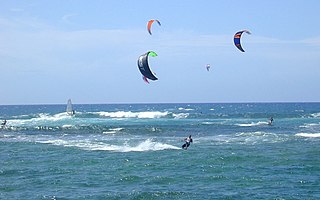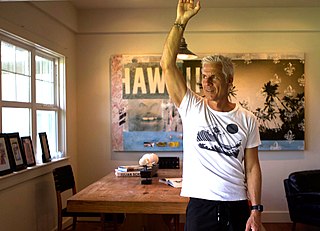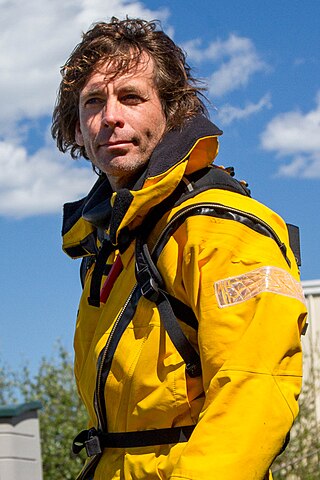Boardsports are active outdoor sports that are played with some sort of board as the primary equipment. These sports take place on a variety of terrains, from paved flat-ground and snow-covered hills to water and air. Most boardsports are considered action sports or extreme sports, and thus often appeal to youth. Some board sports were marginalized in the past. However, many board sports are gaining mainstream recognition, and with this recognition, they have enjoyed wider broadcast, sponsorship and inclusion in institutional sporting events, including the Olympic Games.

Kiteboarding or kitesurfing is a sport that involves using wind power with a large power kite to pull a rider across a water, land, or snow surface. It combines the aspects of paragliding, surfing, windsurfing, skateboarding, snowboarding, and wakeboarding. Kiteboarding is among the less expensive and more convenient sailing sports.

Windsurfing is a wind propelled water sport that is a combination of sailing and surfing. It is also referred to as "sailboarding" and "boardsailing", and emerged in the late 1960s from the Californian aerospace and surf culture. Windsurfing gained a popular following across Europe and North America by the late 1970s and had achieved significant global popularity by the 1980s. Windsurfing became an Olympic sport in 1984.

A power kite or traction kite is a large kite designed to provide significant pull to the user.
A foilboard, also known as a hydrofoil board or foil surfboard, is a type of board used in water sports; it is distinct from surfboards in that it has a hydrofoil rather than fins mounted underneath. This hydrofoil design allows the surfboard and its rider to rise above the water’s surface, allowing for fast speeds and increased maneuverability in a wide range of surf conditions. Foilboards are becoming increasingly popular across many water sports, including surfing, kiteboarding, and wakeboarding. Foilboards have also been used in competitions, with riders reaching speeds of up to 30 km/h while performing acrobatic maneuvers such as flips, twists, and more.

A windsport is any type of sport which involves wind-power, often involving a non-rigid airfoil such as a sail or a power kite. The activities can be land-based, on snow, on ice or on water. Windsport activity may be regulated in some countries by aviation/maritime authorities if they are likely to interfere with other activities. Local authorities may also regulate activity in certain areas, especially on crowded beaches and parks.

Kite landboarding, also known as land kiteboarding or flyboarding, is based on the sport of kitesurfing, where a rider on a surf-style board is pulled over water by a kite. Kite landboarding involves the use of a mountain board or landboard, which is essentially an oversized skateboard with large pneumatic wheels and foot-straps. Kite landboarding is a growing sport, and there are several competitions. Kite landboarding is attracting growing publicity although it is not yet as popular or as well known as kitesurfing.

The sit-down hydrofoil, first developed in the late 1980s, is a variation on water skiing, a popular water sport. When towed at speed, by a powerful boat or some other device, the board of the hydrofoil 'flies' above the water surface and generally avoids contact with it, so the ride is largely unaffected by the wake or chop of the water and is relatively smooth. The air board is a modified hydrofoil where the skier stands up.

Robert Staunton Naish is an American athlete and entrepreneur who has won 24 World Championship Windsurfing titles. He is also considered a pioneer of kiteboarding and standup paddleboarding.

A sailing hydrofoil, hydrofoil sailboat, or hydrosail is a sailboat with wing-like foils mounted under the hull. As the craft increases its speed the hydrofoils lift the hull up and out of the water, greatly reducing wetted area, resulting in decreased drag and increased speed. A sailing hydrofoil can achieve speeds exceeding double and in some cases triple the wind speed.

Pete Cabrinha is an American big-wave surfer, windsurfer, kitesurfer and artist. He is the founder and brand manager of Cabrinha Kites.

Jim Drake was an American aeronautical engineer who is widely credited with the invention of the sport of Windsurfing. He patented his windsurfing concept in 1968. Drake conceptualized, designed and hand built the first board and articulating sail rig prototype in his garage. He started the sport's first company, Windsurfing International. He produced multiple championship winning windsurfing board designs throughout his career, as well as created a popular offshoot of windsurfing with the world's first un-masted wing sail. Drake would go on to become an altruistic figure head for the sport he pioneered over the course of his lifetime.

The International Kiteboarding Association (IKA), is the only kiteboarding class inside the International Sailing Federation (ISAF). The IKA class rules fall in the category of a development class.
Jimmy Lewis is a Hawaiian surfer, sailor and surfboard shaper.

Francisco Lufinha, achieved several world records, namely the Fastest Atlantic Kiteboat Crossing (solo) in 2021 and the Longest Journey Kitesurfing in 2015. He is a completely passioned by nautical sportsman. Taken aboard a boat by his parents only 15 days after he was born, he was never able nor wanted to let go of the sea again.

Donald Lewis Montague is a Canadian-American watersport athlete and designer. He is President of Kai Concepts, co-founder of Makani Power, and the head of the Kiteboat Project in Alameda, California.
Ben Wilson is an Australian kitesurfer notable for holding the record for kitesurfing the largest wave ever captured on film; In 2011, Ben successfully kited Fiji’s most infamous wave, Cloudbreak at 35-foot. There have been many attempts by the next generation of kitesurfers including Nicolo Porcella and Jesse Richman to best this feat but as yet there has been no successful attempt.
Formula Kite is the kitesurfing class chosen by World Sailing for the 2024 Summer Olympics. The class features a foil kite and a board with a hydrofoil. The equipment is not one-design, but instead competitors use their choice of approved production equipment. The International Kiteboarding Association (IKA) manages the class. The class is for men and women.















